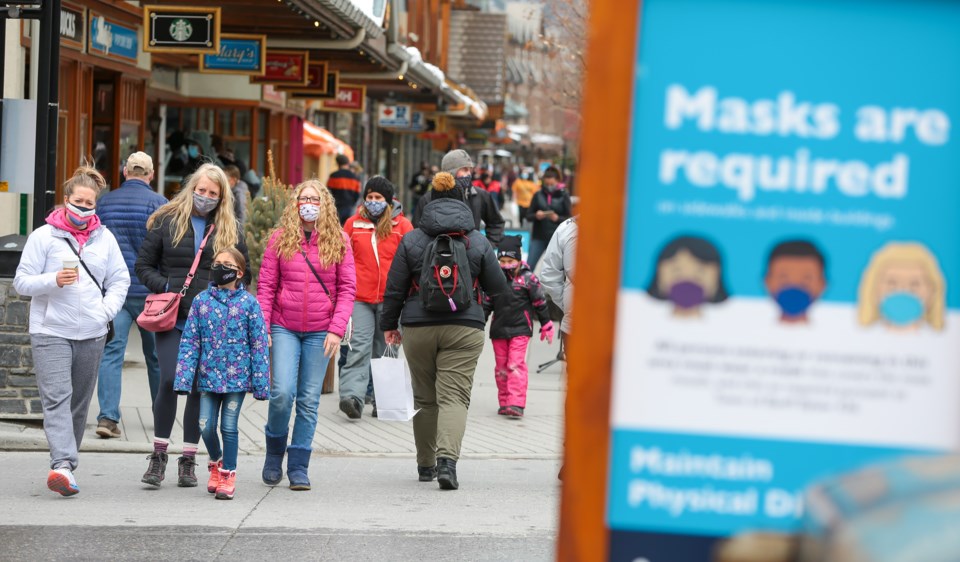BANFF – A local tourism organization is calling on Banff’s elected officials to scrap the mandatory mask bylaw to bring the tourist town in line with the rest of the province when Alberta lifts COVID-19 restrictions as part of its Open for Summer plan.
With restrictions expected to go as early as the end of June based on vaccination and hospitalization rates, the Banff and Lake Louise Hospitality Association is looking to the Town of Banff to align its messaging and policies to provincial health restrictions.
“We are looking to the Town to rescind the Banff’s temporary mask bylaw on, or prior to, the Alberta government’s anticipated lifting of the province-wide mask mandate, which is expected this month,” said Darren Reeder, the group’s executive director, in a June 7 letter to council.
“In the same manner we aligned as destination leaders to support the health, well-being and safety of our community when it mattered most, with our vaccination path on track – thanks to the strong uptake of local residents – it’s time to welcome visitors back to our community and rebuild the foundation of our tourism economy.”
Town of Banff administration plans to ask council for direction on the mandatory mask bylaw – which includes mask wearing outdoors in much of the downtown and a stretch of Banff Avenue into the hotel district – at its meeting on Monday (June 14).
Last month, Premier Jason Kenney announced the province’s Open for Summer Plan, which has the potential to remove the provincial mask mandate by late June, or into early July.
Town Manager Kelly Gibson said because outdoor masking is not currently mandated by the province, Banff’s outdoor mask bylaw could be kept in place by council or removed at any time.
As for indoors, Gibson said council has several options to explore as provincial COVID-19 restrictions lessen, including leaving the indoor masking bylaw in place until such time council felt comfortable removing it.
“While this ensures council controls the decision on when to release this requirement, it may cause conflicting communications with residents and visitors on reopening measures when messaging will be coming from the province that the mask mandate has been lifted,” he said.
Another option is to pass a new bylaw that would remove the indoor masking requirement.
“This would not immediately remove the requirement for indoor masking because of the provincial masking mandate currently in place and would be in effect until the province removed their masking mandate,” Gibson said.
The events of the past 15 months have been unlike anything Banff has ever experienced, seeing about 80 per cent of the workforce out of jobs when the pandemic first hit in March 2020 and ongoing uncertainty with on-again, off-again restrictions.
“With the release of the government of Alberta’s Open for Summer plan, however, there has been a palpable shift in optimism and an eagerness amongst our business constituents to welcome visitors back to Banff National Park,” Reeder said.
The work done by BLLHA and other partners, such as Banff and Lake Louise Tourism, Parks Canada and the municipality this past year to support the community and local business members, has been informed by the economic task force.
Reeder said the foundational objective of the task force was to work to safely reopen, adding after more than a year of being in a holding pattern, the tourism industry is ready to move ahead with plans from business reopening to a sustainable economy.
“With the destination now decidedly moving towards reopening for summer, we are looking to the Town of Banff to amplify our messages and join us in turning the page to welcome visitors back to safely experience the destination,” he said.
Reeder said it is understandable that not everyone may feel comfortable with the return of visitors as many people have, and may continue to be, impacted by the lingering effects of COVID-19.
“However, our shared efforts must be informed by what the data is telling us and then relating that in a manner that is sensitive to all audiences with whom we communicate,” he said.
Banff National Park, which includes Banff and Lake Louise, went from the No. 1 COVID-19 hotspot in the province after peaking at 164 active cases on April 25 down to four active cases by June 9.
There have been 806 reported cases in Banff and Lake Louise since the pandemic began, which includes 801 recoveries and one death. The current per capita rate is 29.7 per 100,000 people.
With 7,897 people having had their first jab, the percentage of people immunized with at least one dose is believed to be more than 90 per cent, based on a population estimate of 9,500 for Banff and Lake Louise.
Concerns, however, continue to be raised about the effectiveness of vaccines against the new delta variant, which was originally detected in India, and is now prevalent in Calgary.
Officials with Alberta Health Services say evidence suggests it is more transmissible, noting one dose only offers 33 per cent protection and two doses 88 per cent protection.
“They still appear to provide some protection, and the good news is that two doses are virtually as effective against B.1.617 as any other strain,” said Dr. Deena Hinshaw, Alberta’s chief medical officer of health.




